As Moguls Make Sun Valley Plans, Fear of Big Tech Echoes in Dealmaking Haven
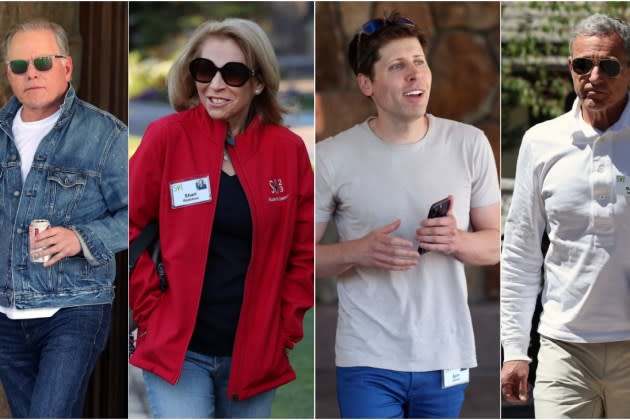
It started with the conspicuous TV news crews. “I get out of my car and see five media vans with the dishes and everything. It was weird. It’s very different than last year. There are reporters everywhere,” so relayed one Sun Valley attendee, speaking anonymously to The Hollywood Reporter for a July 1999 news item in the trade daily.
Until then, investment banker Herb Allen’s exclusive “summer camp for moguls” was said to be (mostly) free of large numbers of reporters roaming about asking executives outside the Idaho conference for quotes or looking for deal gossip. There were few of the candid images of Patagonia-fleeced execs — name tag and sunglasses on, to-go coffee cup in hand, warily eying a photographer — that now litter Getty Images annually, to be reused for M&A chatter or eye-popping salary disclosure items.
More from The Hollywood Reporter
Sports TV's Multibillion-Dollar Rights Race: Where the Leaderboard Stands Right Now
Streaming Profits Are Tough to Find. Niche Movie and TV Platforms See a Way Forward
Shari Redstone Goes for Broke: Can Paramount Pick Up the Pieces?
The potential of the internet was just beginning to turn into a tsunami on Wall Street, but few knew where and how the wave would land. Portal deal ideas were the rage. AOL was obviously ascendant. The Hollywood crowd that attended was no longer the “It” crew. A must-see panel was “The Internet and Our Lives,” with Amazon’s Jeff Bezos and Yahoo co-founder Jerry Yang. (This was when Bezos still needed to sling barbs at brick-and-mortar rival Barnes & Noble, telling a New York Daily News reporter that critics thought Amazon was “toast” when its competitor started a website, but instead Amazon went from “1 million to 10 million” shoppers.)
The entertainment industry needed to change how it did business and Silicon Valley, buoyed by the dot-com bubble, held all the promise. Sound familiar? A quarter century later, many of those same bold-faced names — Jeffrey Katzenberg, Barry Diller, Warren Buffett and Bill Gates — who attended the Allen & Co. conference still hold sway. But it’s moguls like OpenAI chief Sam Altman, who has attended the confab multiple times over the past decade, who now arguably set the broader narrative.
In ‘99, online giants were seen as heralding the future of how consumers would find content. This was seven years before Google even bought YouTube for $1.6 billion and YouTube execs had deflected rumors about offers while mingling with media CEOs at Sun Valley. It was four years before Myspace kick-started a social media boom that Facebook ran away with and one month after the launch of a website that would upend the music industry: Napster.
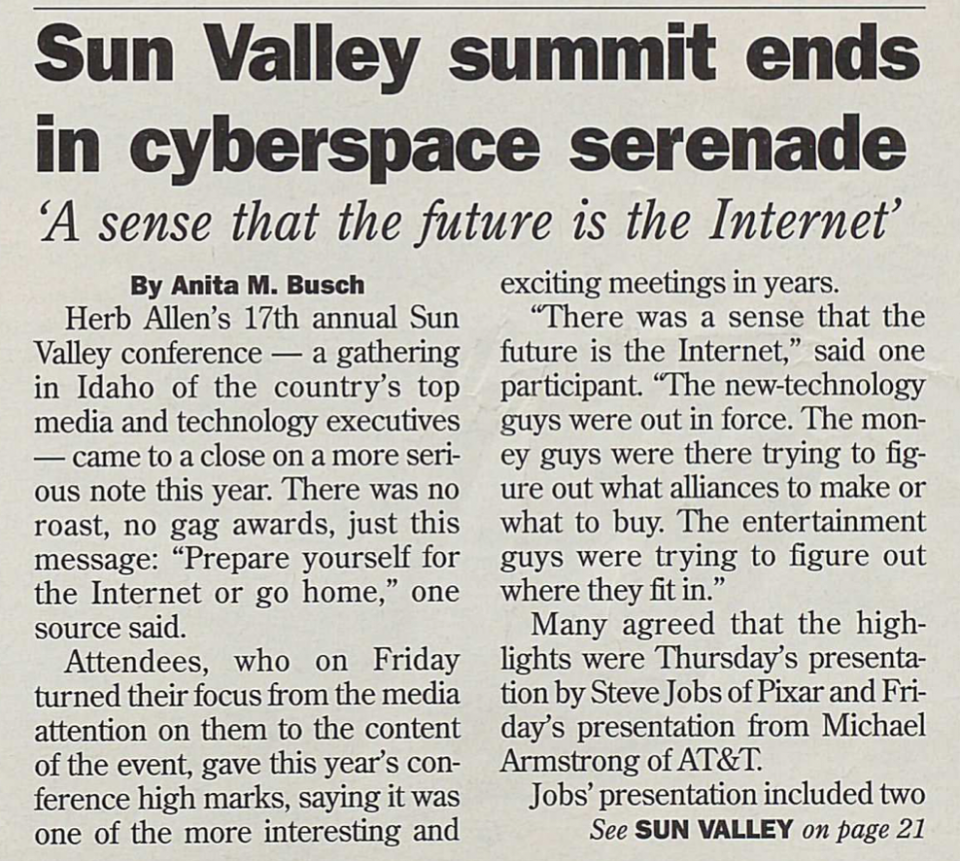
Now both Big Media and Hollywood are preoccupied with how much generative artificial intelligence will disrupt their businesses, and how much they’ll have to remake themselves with AI in order to be seen as efficient publicly traded companies. Microsoft, Google and Apple’s embrace of the evolving tech and some ominous comments by Katzenberg (AI can cut the cost of animated movies by up to 90 percent) and Tyler Perry (Why build an $800 million studio when AI can replicate a ton of what we’re doing?) have only heightened anxiety among industry workers.
The sense of unease, then and now, that executives need to make some big changes, and soon, in order to right the ship to future-proof their firms is pervasive. “We all feel that we’re on the verge of a big transition … a real convergence of technology and content,” an unnamed guest remarked to then THR editor Anita Busch for an article timed to the end of the ’99 conference. And, in echoing a “haven for dealmakers” theme that has been the Allen & Company confab’s calling card, this guest noted, “Everyone was talking to everyone. I don’t know of any deals done there, but I’m sure a lot were started.”
That year, rumors included talks between DreamWorks and Universal and speculation of whether Sony would spin off its entertainment assets or make an alliance with another studio or network. At the time, Sony was said to be more interested in a pact with an internet company. “Partnering with another traditional company in the eyes of Wall Street wouldn’t make sense unless we could make it more melodramatic, more digital in some distinctive way,” then-Sony U.S. chief Howard Stringer relayed to Bloomberg at the time. (Now, Sony and private equity giant Apollo had been in the mix on an offer for Paramount, one of many suitors for the embattled movie and TV empire.)
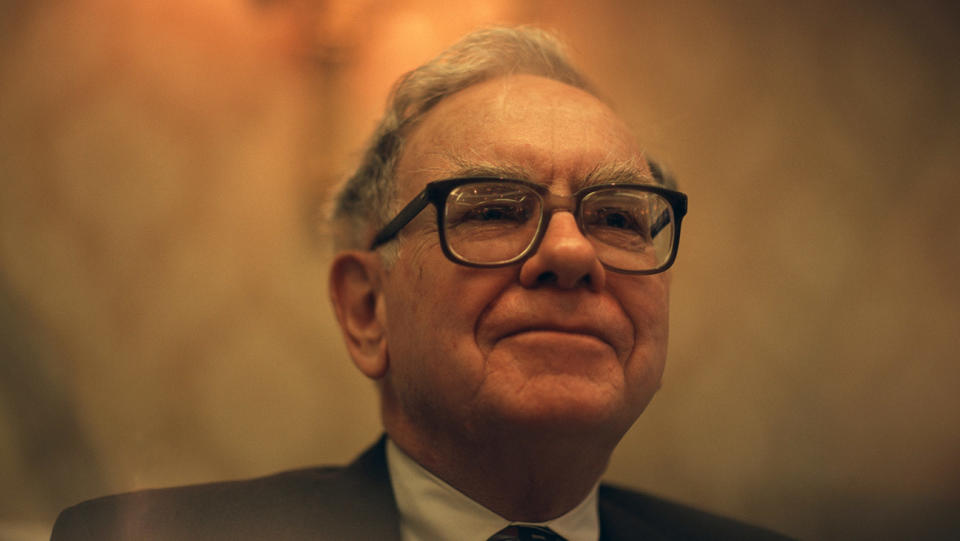
In 1999, Warren Buffett struck an infamous note of caution in a speech about investment results, with an eye to the would-be moguls seeking their fortune on the gold rush of early dot-com ventures. The Berkshire Hathaway chief asked the Sun Valley attendees to consider the car and aviation industries, which “transformed this country much earlier in this century,” and noted that 70 car manufacturers and 300 airplane companies were whittled down to just a handful of winners.
“After corporate carnage that never let up, we came down to three U.S. car companies — themselves no lollapaloozas for investors. So here is an industry that had an enormous impact on America — and also an enormous impact, though not the anticipated one, on investors,” Buffett’s remarks read. “Sometimes, incidentally, it’s much easier in these transforming events to figure out the losers.”
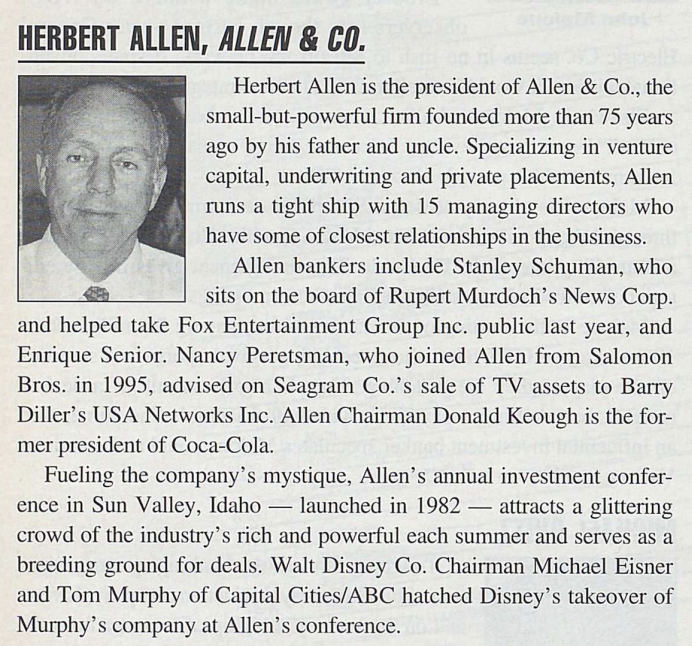
With hindsight, it’s not difficult to connect the dots from Buffett’s stark speech to the era of the Streaming Wars, where nearly every major traditional media company chased Netflix’s business model at the end of the last decade, poured billions into their own direct-to-consumer platforms during the pandemic and now face headaches, mounting bills and calls to merge, bundle or abandon the model.
When photographer Annie Liebowitz convened a July ’99 New Establishment group portrait of 24 business luminaries in a setting off Sun Valley’s Corral Creek Road (Dell chief Michael Dell was pictured on horseback) that would run months later in Vanity Fair, Time Warner president Richard Parsons was staged next to America Online president Bob Pittman, while Bob Iger, then chairman of ABC Group, sat smiling on a tech-heavy side just below Apple CEO Steve Jobs.
Less than a year after that photo, the big move happened: AOL bought Time Warner in an infamous $182 billion merger that resulted in an astronomical write-down of $99 billion and the tag of “most disastrous deal ever” hanging over it for decades. (The logic behind telcom giant AT&T’s $85 billion acquisition of Time Warner in 2016 arguably makes that deal one of the runner-ups.)
As for the hyped, Tom Brokaw-moderated “Internet and Our Lives” panel, media reporter Ken Auletta succinctly boiled down the ’99-era insights from Bezos, Yang and Dell. “Is the Internet another tulip craze? (No.) Will retail shopping survive? (Yes.) Do brand names matter in this strange new world? (Maybe.),” Auletta wrote in his New Yorker essay that July, aptly headlined, “What I Did at Summer Camp.” Twenty five years later, studios are still figuring out internet content economics while publishers and digital media companies are wondering how much equity exists in their brands in a fractured landscape.
This year, as many of those same executives disembark off private jets in Idaho, Warner Bros. Discovery, one remnant from that infamous AOL deal that was unwound years earlier (AOL, like Yahoo, is now owned by Apollo), is trading near its lows as investors haven’t entirely bought into the debt-laden, pure-play media vision outlined by chief David Zaslav. Disney, with Iger once again at the helm, is promising that it’s thisclose to streaming profitability and planning to dial back its spending on streaming-only fare.
And Paramount Global sits in a state of swirling uncertainty with three co-CEOs ready to steer the ship one direction — unless controlling stakeholder Shari Redstone swerves a different way and sells all or part of her combined CBS and Viacom empire. (Buffett, once one of Paramount’s top stockholders, sold all shares this year at a big loss.) It’s an admission that the business built and managed, a collection of largely linear TV assets like CBS, Showtime, Nickelodeon, Comedy Central, BET and MTV, may not be enough to keep pace with the publicly traded giants on the market now.
That sentiment, too, was expressed years ago at Sun Valley. “The age of the conglomerate is over,” THR quoted Viacom chairman Sumner Redstone saying to reporters at the 2005 edition of the Allen & Co. conference. “I don’t know why conglomerates are not working. The world has changed and, anyhow, it hasn’t worked out. None of the companies has done that well but we’re prepared to do something about it.”
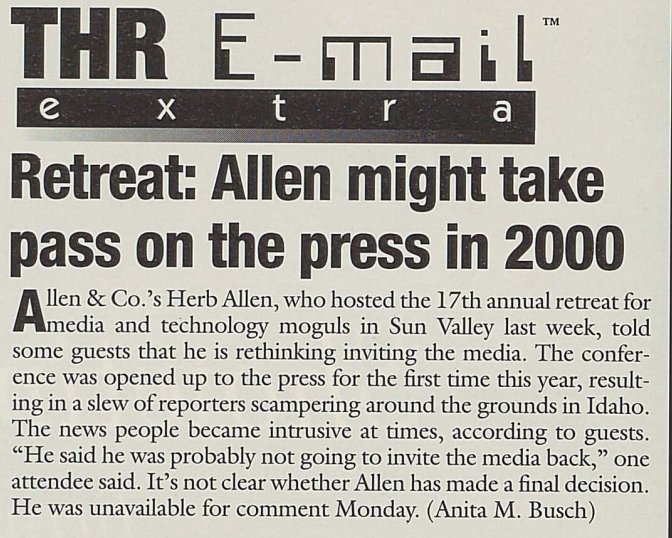
Days after the 1999 conference ended, the Reporter published a brief item noting that Allen himself was second-guessing giving the press some access. “He said he was probably not going to invite the media back,” one guest told the paper. The press did return (see: the brief CNBC TV hits that execs regularly make now). The existential fears, and hopes, about Big Tech never left.
Best of The Hollywood Reporter

 Yahoo Finance
Yahoo Finance